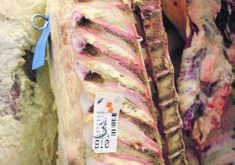XL Foods report | PSAC president says better training, more inspectors needed
Food inspectors at the XL Foods plant, which triggered the largest beef recall in Canadian history last year, were not the source of the problem, says their union leader.
Bob Kingston, president of the agricultural union of the Public Service Alliance of Canada, said front-line inspectors were often following the lead of their managers.
“It was an open secret for a long time that there was a coziness between some of the CFIA (Canadian Food Inspection Agency) people and the (meat packing) industry in Alberta,” he said.
Read Also

New coal mine proposal met with old concerns
A smaller version of the previously rejected Grassy Mountain coal mine project in Crowsnest Pass is back on the table, and the Livingstone Landowners Group continues to voice concerns about the environmental risks.
“There were old school managers in that part of the country that were a bit of a problem. If they say there was a relaxed attitude (to food safety), some of that was a hangover and a lot of it has been addressed. Some of those managers have been replaced.”
An expert panel report on the E. coli outbreak at the XL plant in Brooks, Alta., which was published in early June, said there was a “weak food safety culture at the Brooks plant shared by plant management and CFIA staff,” and the food safety crisis could have been averted.
CFIA president George Da Pont said part of the problem was the fact that many inspectors are embedded in plants for years, and “there is a possibility they might not be as rigorous after 10 or 15 years as they were at the start.”
Kingston said the report conclusion was startling for many Canadians. Conversations with the panel during its work had made him “aware of the scenario out there, but I can see how a lot of people could have been alarmed and troubled.”
He said part of the problem was that some managers accepted the view that part of the CFIA mandate was to help trade “as a balanced mandate of the agency.”
Younger inspectors uncertain of their jobs would not necessarily challenge that view, particularly if managers and plant officials were close, he said.
“Often the inspectors were of the impression that the managers had taken the side of …. let me put it another way because it isn’t about sides,” he said.
“If there was any push back from the facility, the impression the inspectors were given was to go a little easier, don’t be so hard on them. That kind of response from management does not encourage diligence.”
Kingston insisted that part of the problem is the lack of inspection staff and training.
He rejected the idea that an answer is to move staff regularly between plants so that they do not become too close to those they regulate.
Kingston, who is a former inspector, said that was tried in the 1990s.
“It was a logistical nightmare and an economic nightmare and it became an operational and morale nightmare as well.”
He accepted the argument that embedded inspectors could become too identified with their plant in some cases, imagining that they would be out of a job if they found problems that would close it down.
Instead, if they are properly trained, they would understand doing their job would make the plant better, enhance the reputation of the CFIA and preserve inspection jobs in the long run.
Instead of moving inspectors from plant to plant, a better solution is to not let them become isolated but to keep them in the CFIA loop, he said.
“If you allow people to be isolated from the CFIA culture in isolated locations, they can lose sight of the long-term objective,” he said.
“The potential is there, but there are better management tools available to deal with it than just uprooting people, which could simply end up with a demoralized and disloyal workforce.”

















